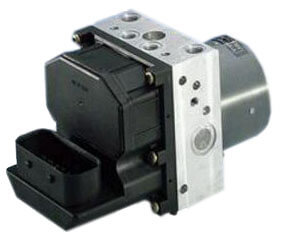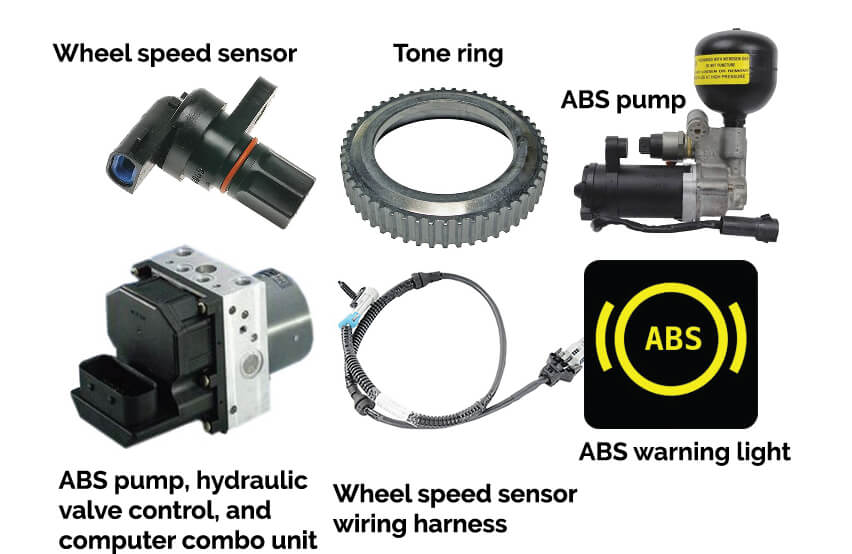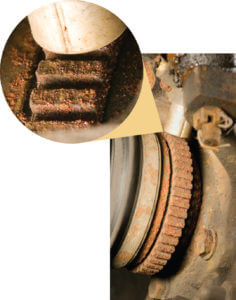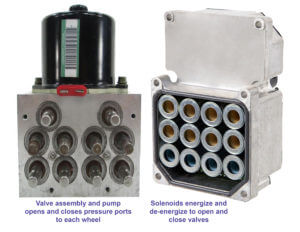ABS brake components

ABS brake components
ABS wheel speed sensors
ABS brakes sense wheel speed using either an active or passive wheel speed sensor. The sensor detects the wheel rotation by monitoring a toothed ring or magnetic multipole ring mounted on the axle shaft or wheel bearing.
ABS hydraulic unit
The ABS hydraulic unit then releases brake pressure to the wheel cylinder or caliper on the rapidly slowing wheel, allowing it to regain speed. Then the system applies brake fluid pressure again to slow the wheel at the same rate the other wheels are braking. The ABS system repeats the release/apply procedure in rapid succession to provide braking without skidding.

How does the ABS system work?
An ABS system consists of individual wheel speed sensors, an electronic brake control module (EBCM) and a hydraulic control unit with an integral pump. The hydraulic control unit contains electronic circuitry and solenoid valves. The valves are located in series with the brakes lines running from the master cylinder to the wheel cylinders or calipers.
During an ABS operation, a dump valve opens to release brake fluid pressure. When it’s time to reapply pressure, another valve opens to apply pressurized brake fluid from the pump to flow to the wheel cylinder or caliper to reapply the brakes at that wheel.
How a wheel speed sensor works?
Wheel speed sensors work in conjunction with a tooth or notched ring.  Called a tone ring. The wheel speed sensor is either an active or passive design.
Called a tone ring. The wheel speed sensor is either an active or passive design.
A passive wheel speed sensor doesn’t power from the EBCM. As the tone ring rotates, each tooth passes across the magnetic field of the passive sensor, allowing it to generate a low voltage alternating current signal. Increased wheel speed results in a slightly higher voltage and more alternating sine waves. The EBCM compares the amplitude and frequency of these waves from each wheel to determine wheel speed.
An active wheel speed sensor requires power and also detects the rotation of the teeth on the tone ring. But instead of supplying an AC voltage to the EBCM, it provides a varying DC voltage or a digital signal. Active wheel speed sensors are more accurate than passive sensors and are used most often in late model vehicles.
What goes wrong with ABS brakes?
The wheel speed sensors, tone rings and wiring harness are the most common failure items in an ABS brake system. The wheel speed sensor and tone ring operate in a harsh environment where they’re subjected to severe vibration up and down and turning movement. In addition, they’re exposed to, ice, snow, sand and road salt and corrode the tone ring and invade the electrical connector.
The EBCM, hydraulic control unit and pump can also fail, although  those failures are less frequent. Since the hydraulic control unit operates the solenoid valves, the magnetic coils can fail, causing a trouble code in the EBCM computer, which turns on the ABS warning light and disables the ABS brakes.
those failures are less frequent. Since the hydraulic control unit operates the solenoid valves, the magnetic coils can fail, causing a trouble code in the EBCM computer, which turns on the ABS warning light and disables the ABS brakes.
Once an ABS related trouble code sets and the warning light turns on, the driver can continue to drive and brake, but without ABS braking action.
If your ABS warning light is on, read this post
If your ABS hydraulic unit has failed, read this post on the best way to get it repaired.
©, 2017 Rick Muscoplat
Posted on by Rick Muscoplat
